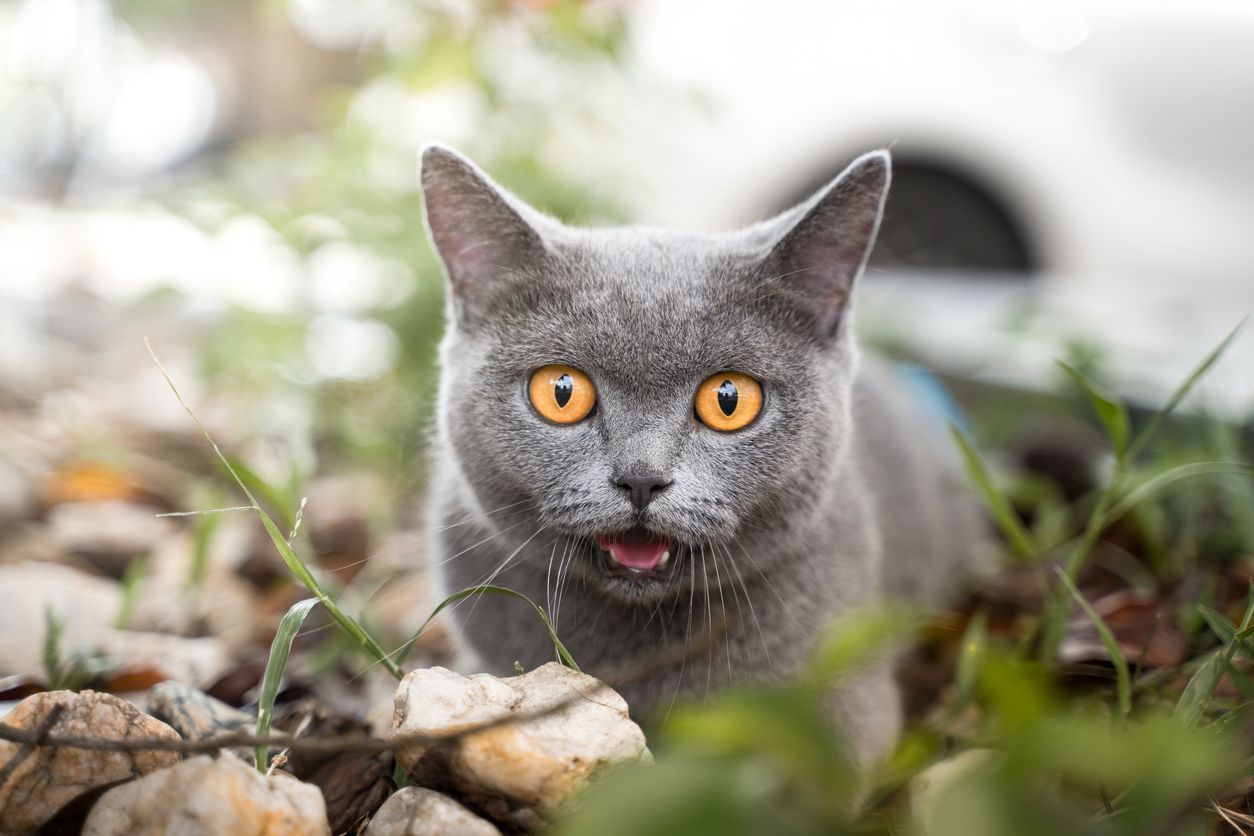Detection and management of cognitive dysfunction in cats

Disclaimer: This article, its content, and its related references do not constitute veterinary advice and should not be considered a substitute for veterinary care. If your pet is showing any symptoms that could indicate a medical emergency, please seek immediate emergency care.
Feline cognitive dysfunction syndrome (CDS), also known as feline dementia, is an age-related neurodegenerative disease similar to Alzheimer’s disease in humans. It results in progressively worsening cognitive function relating to memory, awareness, and behavior. The risk of developing CDS increases with age, and more than 20 percent of cats over the age of ten show some clinical signs of dementia. If you have a senior cat, read on to discover:
- How feline dementia affects the brains of cats
- Common signs of CDS in cats
- How cat owners can help their pets with CDS
CDS results in progressive behavioral changes, such as pacing, increased vocalization, altered sleep cycles, house-soiling, and more. There are no medications approved by the FDA specifically for the treatment of feline CDS, and it cannot be cured. However, some evidence suggests that various management methods can improve quality of life and may slow the progression of the disease. These include environmental enrichment, medication, and food and supplements containing ingredients thought to help with cognitive function, such as omega-3 fatty acids.
What is feline cognitive dysfunction syndrome?
Cognitive dysfunction syndrome (CDS), or dementia, is a chronic, degenerative disease that results in a progressive decline in a cat’s cognitive function. The condition is similar to Alzheimer’s disease in humans and is common in cats over the age of ten. As cats get older, age-related changes occur in the brain: brain cells (neurons) begin to deteriorate, and beta-amyloid plaques may accumulate and contribute to a toxic environment for neurons, causing more damage. Once neuron damage occurs, it can’t be reversed.
Age-related cognitive decline in cats progresses over time and cannot be stopped, cured, or reversed. However, with various management strategies, it may be possible to slow its progression and improve quality of life. Dementia in cats is not painful or fatal, but it can lead to a poor quality of life and potentially impact an owner’s decision on when to consider humane euthanasia, especially if the cat has other age-related medical conditions, such as chronic kidney disease.
Clinical signs of feline dementia
Behavior changes associated with CDS include:
- Pacing and other repetitive behaviors
- House-soiling
- Vocalizing more for no apparent reason
- Altered sleep/wake cycles
- Changes in normal social interactions, such as becoming irritable or aggressive toward familiar humans and other pets
- Disorientation, wandering, or getting lost in familiar settings
- Staring blankly for long periods of time
- Low activity levels
- Less interest in play or toys
- Decreased grooming
- Loss of appetite and drinking less water
Symptoms of CDS vary between individuals and usually get worse over time. Behavior changes are often more intense at night.
More than 20 percent of cats over the age of ten show some signs of dementia. This increases to more than 50 percent for cats over the age of 15. “It’s important not to assume a cat’s physical or behavioral changes are simply due to old age,” explains Dr. Jo Myers, a veterinarian on the Vetster platform. “Aging is not a disease, but senior cats are at a higher risk for certain health issues.” Cats with dementia may have other comorbidities that make CDS symptoms worse.
Diagnosis and management of cats with dementia
Diagnosis of CDS is often made based on a description of a senior cat’s altered behaviors once diagnostic tests rule out other possible explanations. There is no specific test for CDS in cats. Videos of abnormal behaviors may be helpful, as cats may not show the same behaviors in a veterinary clinic. An online vet may be able to help identify signs of CDS by virtually observing a cat’s behavior in their own home.
There is no one-size-fits-all approach to treating feline dementia. A combination of behavioral enrichment, diet change, and medication may help minimize symptoms, improve quality of life, and slow the progression of the disease.
Mental and environmental enrichment
Providing mental stimulation and environmental enrichment keeps the brain and body active, and encourages strong neural pathways and brain function. Behavioral enrichment may involve:
- Revolving toy selection and offering different types of toys
- Setting up window perches and outdoor bird feeders
- Food or treat puzzles
- Regular interaction for grooming and play
Simple toys, such as cardboard boxes, wand toys, and batting toys, can encourage a senior cat to play, exercise, and explore. Cognitive tasks, such as food puzzles, can also keep cats busy and encourage brain activity. Encouraging activity during the day can help regulate a cat’s sleep patterns and reduce nighttime restlessness.
Other environmental changes that may help symptoms and improve quality of life include:
- Avoiding changing the locations of furniture, bowls, beds, and litter boxes
- Providing multiple senior-friendly litter boxes throughout the home, such as low-sided litter boxes that are placed in easily accessible locations
- Having multiple comfortable areas to hide and rest away from people
Changes to a senior cat’s environment or normal schedule can cause stress, worsening CDS symptoms. When introducing changes, go slowly and watch for negative reactions. Some trial and error may be necessary when attempting to balance stimulation to delay cognitive decline with stress minimization.
Diet modification
Some diets and dietary supplements are formulated to try to help cognitive function in senior cats. While evidence supporting their efficacy is limited, potentially helpful ingredients include:
- Supplements to support brain health and reduce inflammation, like SAMe (Sadenosylmethionine) and omega-3 fatty acids
- Antioxidants to potentially protect neurons, like vitamins E and B
- Phosphatidylserine for supporting the health of brain-cell membranes
Keeping a regular feeding schedule may help cats with CDS. The use of an automatic feeder can help maintain a regular schedule.
Talk to a veterinarian before changing your cat’s diet or giving nutritional supplements. Senior cats with CDS often have other health conditions that may also need to be considered when choosing supplements or a special diet. Professional guidance is also helpful for selecting supplements that are more likely to be beneficial because they’re appropriately formulated and contain what they claim to on the label.
Medication
There are no medications approved by the FDA for the treatment of dementia in cats. However, some medications have shown potential positive effects for some symptoms associated with CDS, such as:
- Anti-anxiety medication
- Medications or supplements for sleep
- Medications to encourage blood flow to the brain and enhance brain function
Talk to a veterinarian before attempting to give your cat medication, even if it’s available over the counter.
Other management methods
Other management methods for dementia in cats may include:
- Pheromone therapy
- Compression clothing for anxiety
- Massage and physical therapy
Evidence supporting the effectiveness of these methods in cats is limited. However, the potential for at least some positive effects is plausible. An online veterinary professional can help cat owners decide which therapies may benefit their pets based on their presenting symptoms.
What to do if your cat is showing signs of cognitive decline
Talk to a veterinarian if your cat is showing behavioral changes, even if they seem otherwise healthy. Multiple health issues, including CDS, can lead to behavior changes. Take a video or make a list of changes, even if they’re small or subtle; cats may not show these abnormal behaviors in a vet’s office. A virtual appointment can help by allowing a vet to observe a cat in their own home, where they’re more likely to show abnormal behaviors.
FAQ - Detection and management of cognitive dysfunction in cats
What can you do for a cat with dementia?
Owners of cats with dementia can try to help by providing behavioral enrichment through play and exploration, and by talking to a vet about management strategies, such as therapeutic diets, supplements, and medication. Feline dementia cannot be cured, but the progression can sometimes be slowed, and quality of life may be improved.
How do I know if my cat has cognitive dysfunction?
Symptoms associated with the development of dementia in cats include behavioral signs, such as pacing and repetitive motions, disorientation, increased vocalization for no obvious reason, and alterations in interactions with familiar humans or animals. Senior cats over the age of ten are at an increased risk of dementia. Other illnesses can cause similar signs, so it’s important to have blood work and other diagnostic tests performed before assuming a cat has CDS.
What are the first signs of dementia in cats?
The first signs of dementia in cats are often subtle changes in behavior, such as pacing, house-soiling, increased vocalization, and altered sleep patterns. Clinical signs of dementia get worse over time as the disease progresses. It’s important to talk to a vet if your cat is showing behavioral changes, as many health issues, including dementia, can cause them.




